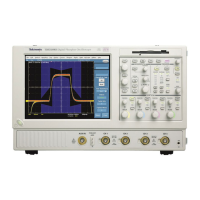Installation Instructions
TDS5000B Series (Option 1R) Rackmount Kit
23
Using the CD Guard
Read these instructions to familiarize yourself with using the CD guard.
It is possible to damage the CD drive if it is accessed while the instrument is all
the way in the rack. If the CD tray is open, and you attempt to slide the
instrument out of the rack, you can break the CD tray. The purpose of the CD
guard is to prevent the CD tray from opening when the instrument is installed all
the way in the rack. This can only be accomplished by having the guard in the
down position.
CAUTION. To prevent damage to the instrument, always put the guard in the
down position before pushing the instrument into the rack.
The rackmount kit includes a bracket with a CD guard tab that mounts on the
front-right side of the instrument. See Figure 12 on page 24. The guard tab is on
the inside edge of the bracket, and prevents the drive from opening when the
guard is in the down (guard) position. A guard status indicator on the front of the
bracket displays red when the guard is in the up (unguarded) position.
CAUTION. To avoid damaging the instrument, first check the guard status
indicator before sliding the instrument in or out of the rack. If it is red, verify
that the CD tray is closed, then push the guard down and move the instrument.
There is no safeguard to prevent the instrument from being pushed into the rack
if the guard is not in the down (guard) position.
CAUTION. To prevent damage to the instrument, always put the guard in the
down position before pushing the instrument into the rack.
Do not eject a CD with the system software while the instrument is all the way in
the rack. If the guard is not in the guard position, the CD tray will become
trapped behind the vertical rack rails, and you will need to close the tray before
you can pull out the instrument. Depending on the location of the adjacent
instruments in the rack, you may have to access the CD tray fr om the back of the
rack.

